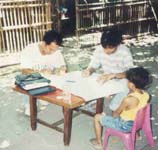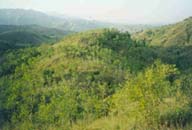 The survey, mapping, and
planning (SMP) for the project started in October 1992. As a result of the SMP, it was
recommended that reforestation and forest protection be employed in the project site. The
NFDO deployed a full-time Site Coordinator to the project as soon as approval was given by
the DENR.
Community Mobilization
 In January 1994,
the FMB-DENR sought the help of the Institute for Development Alternatives (IDA) to
organize the communities living adjacent to the project area. IDA used a community
mobilization development approach called Barangay Cluster Development System (BCDS) in
tapping three contiguous barangays in the municipality to work together on a continuing
basis through people participation. They were able to forge a tighter and closer
inter-barangay relationship among three barangay/communities of Bugallon, namely Cayanga,
Portic and Hacienda. This marked the birth of Bugallon Cluster Multi-Purpose Cooperative,
Inc. (BCMPCI). In January 1994,
the FMB-DENR sought the help of the Institute for Development Alternatives (IDA) to
organize the communities living adjacent to the project area. IDA used a community
mobilization development approach called Barangay Cluster Development System (BCDS) in
tapping three contiguous barangays in the municipality to work together on a continuing
basis through people participation. They were able to forge a tighter and closer
inter-barangay relationship among three barangay/communities of Bugallon, namely Cayanga,
Portic and Hacienda. This marked the birth of Bugallon Cluster Multi-Purpose Cooperative,
Inc. (BCMPCI).
A series of intensive trainings in
psycho-social preparation, capability building, team-working, project management, and
organization strengthening were provided by IDA for the BCMPCI members. Environmental
trainings, with the DENR staff as the resource speakers, were also conducted for the
members to make them appreciate the importance of the forest. The assistance of IDA was
successful as evidenced by the change in the members’ attitude towards government
projects.
Comprehensive Site
Development
 As soon as the
organization was legitimized, a Forest Land Management Agreements (FLMA) was awarded by
the DENR to the BCMPCI in July, 1994. This FLMA is a 25-year renewable lease for the
BCMPCI to reforest, develop, manage, and utilize the 430 hectares of predominantly cogonal
upland area. As steward of the 430-hectare land, the cooperative gets seventy percent of
all the proceeds from forest produce (The remaining thirty percent goes back to the
government/DENR). Each barangay was assigned to take care a specific area. As soon as the
organization was legitimized, a Forest Land Management Agreements (FLMA) was awarded by
the DENR to the BCMPCI in July, 1994. This FLMA is a 25-year renewable lease for the
BCMPCI to reforest, develop, manage, and utilize the 430 hectares of predominantly cogonal
upland area. As steward of the 430-hectare land, the cooperative gets seventy percent of
all the proceeds from forest produce (The remaining thirty percent goes back to the
government/DENR). Each barangay was assigned to take care a specific area.
Activities were planned at
officers’ meetings and general assemblies of the membership. One of the first initial
activities decided by the organization was the production of seedlings. Seedlings of Eucalyptus
camaldulensis, Acacia auri, Acacia mangium, agoho, mahogany, cashew and mango were
among the first species cultivated. As soon as the seedlings are ready for planting, the
reforestation of the area started. Recognizing the financial needs of the community, the
project tried to respond these needs in various ways. Intercropping with income generating
crops was encouraged, and payment for every service rendered by members was practiced.
The reforestation project was
completed by BCMPCI in September 1998, almost three years after the FLMA was awarded. They
have set up five watch towers to ensure the safety and protection of the area against
forest fires and other disasters. Except for the technical support provided by the DENR,
the BCMPCI - now on their own, is successfully managing and maintaining the Bugallon
Forest.
On the other hand, the DENR Regional
Office continuously monitors and evaluates the project through an in-house monitoring and
evaluation team. The DENR Central Office, through the National Forestation Development
Office also visits the project site regularly, particularly during consultation- and
assessment-related activities.
basic info |
initiative | strategy |
critical factors | other links |
home
|

